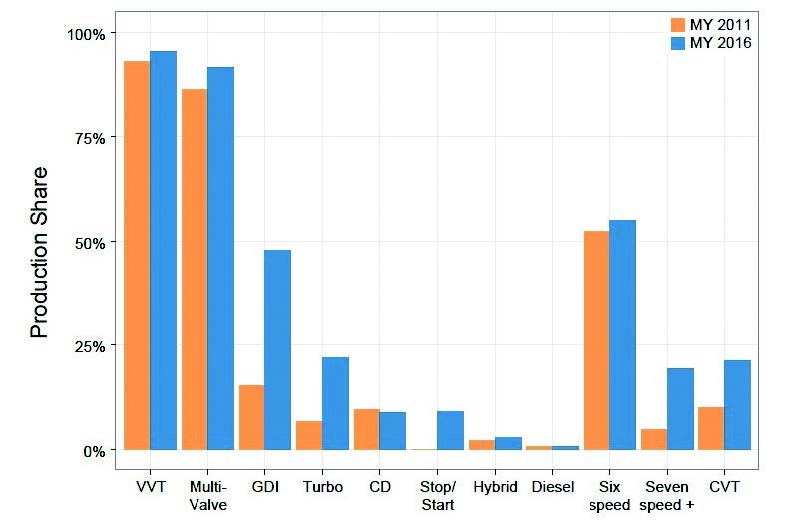The promise of cylinder deactivation
Dr. Edward P. Becker | TLT Automotive Tribology April 2017
With impressive fuel-economy gains, why is this technology stuck at 5% and falling?
THE LATEST U.S. ENVIRONMENTAL PROTECTION AGENCY REPORT on Light Duty Automotive Technology, Carbon Dioxide Emissions, and Fuel Economy Trends is out, and, as always, it presents a treasure trove of information. Figure 1, for example, shows the five-year trend in adoption of various engine and transmission technologies that contribute to better fuel economy.
 Figure 1. Change in technology penetration share. (Figure courtesy of the United States Environmental Protection Agency Report EPA-420-R-16-010, Light Duty Automotive Technology, Carbon Dioxide Emissions, and Fuel Economy Trends: 1975-2016, November, 2016. Available at www.epa.gov/sites/production/files/2016-11/documents/420r16010.pdf.)
Figure 1. Change in technology penetration share. (Figure courtesy of the United States Environmental Protection Agency Report EPA-420-R-16-010, Light Duty Automotive Technology, Carbon Dioxide Emissions, and Fuel Economy Trends: 1975-2016, November, 2016. Available at www.epa.gov/sites/production/files/2016-11/documents/420r16010.pdf.)
Variable valve timing (VVT) and multi-valve per cylinder engines are virtually universal, and gasoline direct injection (GDI) and turbocharging are growing rapidly. Stop/start, where the engine stops running (rather than idling) when the vehicle is stopped and restarts (with the assistance of an electric motor) when the vehicle is required to move, also has gained popularity, along with hybrid powertrains. Even diesel engines have gained slightly. The remaining data are for transmission with six or more forward speeds and continuously variable transmissions (CVT).
The only technology on the chart that has fallen in penetration is cylinder deactivation (CD). Also known as modulated displacement, electronic engine management, active fuel management, displacement on demand and variable cylinder management, this technique involves shutting off as many as half the cylinders in a running engine when power demand is low, usually when cruising at constant speed. This allows the cylinders that are firing to operate closer to their peak efficiency.
Impressive claims are made for the gain in fuel economy from cylinder deactivation (as high as 20% under some conditions but closer to 7% for typical driving cycles). So why is this strategy stuck at around a 5% share and falling? The cost and complexity of the systems to achieve cylinder deactivation are considerable, and the gain in fuel economy is usually only justified for larger engines. At the same time, the market share of four-cylinder engines has been increasing during the last five years, reaching almost 60% at present.
A more fundamental problem, however, is that in their current incarnations, cylinders are not truly deactivated. The valves are deactivated so they remain closed, and whatever gases are in the cylinder at the time of deactivation are effectively trapped. The pistons continue to reciprocate within the bores. Unfortunately, the two largest contributors to friction loss in an engine are the piston rings to cylinder bore and piston skirt to cylinder bore. The total friction loss is somewhat reduced by the absence of combustion pressure, but significant losses remain.
Stopping the pistons from reciprocating is a difficult task and results in other complications. Complicated linkages have been developed, but these add considerable weight, complexity, cost and size to the engine. In addition, stopping individual pistons can result in dynamic imbalance in the engine, which can result in unacceptable vibration in the vehicle.
For now it appears cylinder deactivation in its present form will continue to be used on some larger (V6 and V8) engines, particularly in trucks and performance vehicle applications. Whether its market penetration will continue to shrink, however, will depend on many variables, such as improved materials and manufacturing processes and changes in fuel-economy regulations.
 Ed Becker is an STLE Fellow and past president. He is president of Friction & Wear Solutions, LLC, in Brighton, Mich., and can be reached through his website at www.frictionandwearsolutions.com
Ed Becker is an STLE Fellow and past president. He is president of Friction & Wear Solutions, LLC, in Brighton, Mich., and can be reached through his website at www.frictionandwearsolutions.com.